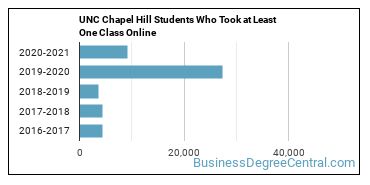University of North Carolina at Chapel Hill Business Programs
University of North Carolina at Chapel Hill is a public institution situated in Chapel Hill, North Carolina. The surrounding area of the school is a good match for students who enjoy city life.
Featured schools near , edit
Where Is University of North Carolina at Chapel Hill?

Contact details for UNC Chapel Hill are given below.
| Contact Details | |
|---|---|
| Address: | 103 South Bldg Cb 9100, Chapel Hill, NC 27599 |
| Phone: | 919-962-2211 |
| Website: | www.unc.edu |
How Do I Get Into UNC Chapel Hill?
You can apply to UNC Chapel Hill online at: https://www.admissions.unc.edu/Apply
Admission Requirements for UNC Chapel Hill
| Submission | Required? |
|---|---|
| High School GPA | 5 |
| High School Rank | 5 |
| High School Transcript | 1 |
| College Prep Program | 5 |
| Recommendations | 1 |
| SAT or ACT Scores | 5 |
| TOEFL | 1 |
How Hard Is It To Get Into UNC Chapel Hill?
Approximately 40% of accepted students are men and 60% are women. The acceptance rate for men is 17%, and the acceptance rate for women is 18%.
Average Test Scores
About 26% of students accepted to UNC Chapel Hill submitted their SAT scores. When looking at the 25th through the 75th percentile, SAT Evidence-Based Reading and Writing scores ranged between 670 and 750. Math scores were between 680 and 780.
Can I Afford University of North Carolina at Chapel Hill?
The net price is calculated by adding tuition, room, board and other costs and subtracting financial aid.
Student Loan Debt
Almost 66% of college students who graduated with the class of 2018 took out student loans, but that percentage varies from school to school. At UNC Chapel Hill, approximately 19% of students took out student loans averaging $6,501 a year. That adds up to $26,004 over four years for those students.
University of North Carolina at Chapel Hill Undergraduate Student Diversity

There are also 11,796 graduate students at the school.
Gender Diversity
Of the 18,931 full-time undergraduates at UNC Chapel Hill, 39% are male and 61% are female.

Racial-Ethnic Diversity
The racial-ethnic breakdown of University of North Carolina at Chapel Hill students is as follows.

| Race/Ethnicity | Number of Grads |
|---|---|
| Asian | 2,395 |
| Black or African American | 1,603 |
| Hispanic or Latino | 1,824 |
| White | 10,544 |
| International Students | 1,018 |
| Other Races/Ethnicities | 1,547 |
Geographic Diversity
North Carolina students aren't the only ones who study at University of North Carolina at Chapel Hill. At this time, 42 states are represented by the student population at the school.
Over 102 countries are represented at UNC Chapel Hill. The most popular countries sending students to the school are China, India, and South Korea.
Online Learning at University of North Carolina at Chapel Hill
The following chart shows how the online learning population at UNC Chapel Hill has changed over the last few years.

This school is the 2nd most popular in North Carolina for online learning according to the online graduations recorded by the Department of Education for the academic year 2022-2023.
The following table shows the 1-year growth rate of UNC Chapel Hill majors that offer at least one online course. This table only includes majors with positive growth.
| Major | 1-Year Growth Rate |
|---|---|
| Accounting | 10% |
| Management Science | 6% |
University of North Carolina at Chapel Hill Business Concentrations
The table below shows the number of awards for each concentration.
| Major | Bachelor’s | Master’s | Doctor’s | TOTAL |
|---|---|---|---|---|
| Management Science | 0 | 744 | 0 | 744 |
| General Economics | 384 | 0 | 0 | 384 |
| General Business Administration and Management | 332 | 4 | 13 | 349 |
| Accounting | 0 | 217 | 0 | 217 |
| Econometrics & Quantitative Economics | 65 | 11 | 9 | 85 |
| General Human Resources Management/Personnel Administration | 81 | 0 | 0 | 81 |
| Organizational Leadership | 0 | 0 | 0 | 0 |
| Other Human Resources Management and Services | 0 | 0 | 0 | 0 |
| TOTAL | 862 | 976 | 22 | 1,860 |
References
*The racial-ethnic minorities count is calculated by taking the total number of students and subtracting white students, international students, and students whose race/ethnicity was unknown. This number is then divided by the total number of students at the school to obtain the racial-ethnic minorities percentage.
- College Factual
- National Center for Education Statistics
- Image Credit: By Marchmain05 under License
More about our data sources and methodologies.
Featured Schools
You have goals. Southern New Hampshire University can help you get there. Whether you need a bachelor's degree to get into a career or want a master's degree to move up in your current career, SNHU has an online program for you. Find your degree from over 200 online programs.
Visit School
